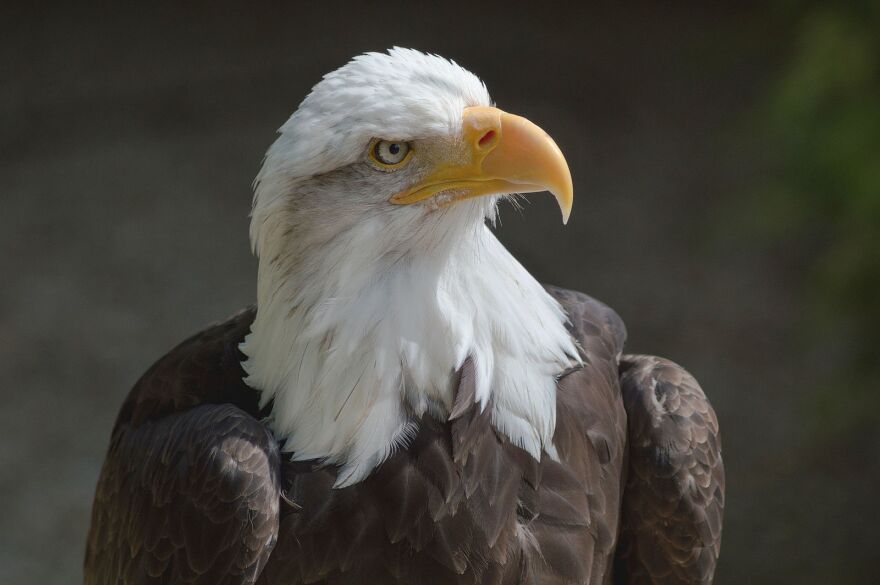Land Between the Lakes is one of the best locations in Kentucky and Tennessee to view several species of eagles, including the bald eagle. Woodlands Nature Station lead naturalist John Pollpeter discusses these striking birds of prey and how to best view them in the wild.
Birds of prey, including the bald eagle and osprey, were reintroduced to the Land Between the Lakes area in the 1980s. Since then, January has been one of the best times of year to view the now abundant bald eagle population of LBL. This is due to a couple of different reasons, Pollpeter begins.
"Because of the colder temperatures you find up North, a lot of eagles will migrate South along the Mississippi Flyway and find Land Between the Lakes to be the first open water in a long distance. So we end up having twice as many bald eagles in the area as we normally do."
"January also happens to be the prime time for eagle breeding," Pollpeter continues. "A lot of eagles you'll see out there, they do this courtship dance [that's] really unique to see. They fly up as high as they can, grasp talons, fall tumbling to the earth, and before they hit the water or the land, they split apart. And in that time period, they may have mated or done their courtship."
Bald eagles are also notably strong and large birds. "Us humans, we have strong hands, but not very strong hands -- about 100 pounds of pressure per square inch, maybe enough to crush a tomato. An eagle has a thousand pounds of pressure per square inch. That's well enough to be able to crush a baseball," Pollpeter says.
Eagles are one of the largest birds of the Land Between the Lakes area. "They have about an eight-foot wingspan," Pollpeter says. "So they're definitely big and beautiful, easy to notice when they're out there flying around. They can see a fish about a mile away. That's a lot better than our eyesight."
"And you know," Pollpeter continues, "in typical American fashion, they also build the biggest houses. I think the largest eagle nest in recorded history is 10-feet across, 20-feet deep, and weighed two tons. That was in Florida. Eventually, the tree broke and fell, but it was a nest that was built over multi-years and probably multi-generations of eagles."
The bald eagle has been America's national symbol since 1782 when it was placed with outspread wings on the country's seal. "It's a good one," Pollpeter says. "It's a very striking animal. It's a bird that even a non-birder can pick out easy enough. We've all seen pictures of it everywhere. When you're out there along the lakeshore and looking at the trees, the white head, the white tail, the brown body really stands out."
"It is a beautiful bird, and every post looks very regal," he continues. "But they really don't get that white head, that white tail, that classic look until they're the age of five. That's when they become sexually mature. Prior to that...they're going to look a little bit like a red-tailed hawk with a brown front."
"From year one to year five, you'll start seeing the change happen where they'll start getting little white feathers here and little white feathers there on the head and the tail. You can actually tell how old a bald eagle is to the age of five by the plumage that they have."
Pollpeter says the Northwest portion of Land Between the Lakes is the best area for eagle-viewing in Land Between the Lakes. "Almost every bay you go to, you're going to see a pair of eagles," he explains. "A couple of locations I would recommend would be Honker Lake, Empire Point, Energy Lake."
"I always try to encourage people to go to the two large dams, the tailwaters -- Kentucky Dam and Lake Barkley Dam. The reason I always try to point people that direction is because there's a lot of food available for them, so the eagles tend to concentrate a little more into those areas," Pollpeter concludes.
The Calloway County Public Library and the Woodlands Nature Station of Land Between the Lakes have partnered to present "Eagle Viewing in Land Between the Lakes, a Nature Webinar" on Saturday, January 30th, 2021, at 2 pm CST. The 45-minute webinar will discuss local conservation efforts that helped bring the bald eagle back from the brink of extinction.
Nature Station naturalists will also share more tips and tricks for finding bald eagles in the wild, helping to create a COVID-friendly, outdoor eagle excursion. The webinar is presented free of charge; however, registration is required. Sign up here.
The Woodlands Nature Station also offers free monthly webinars and homeschool education classes through their Facebook page. February's monthly nature webinar is "Twitterpated: Animals in Love."
For more information on Land Between the Lakes, visit their website.






